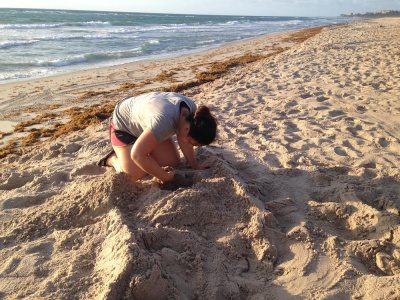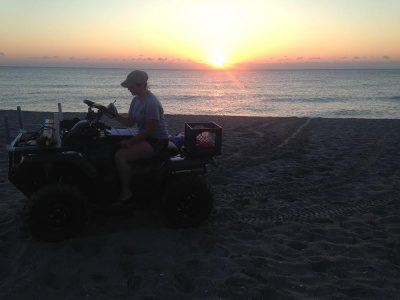Although a part of Loggerhead Marinelife Center’s core, our research team often goes unnoticed. When we feature the research team, we focus on the numbers – 15, 219 loggerhead nests, 160 leatherback nests, 650 green nests. While these numbers are essential to our mission and vision, we leave the public wondering who are the faces behind recording and tracking these numbers? Our research team members – early morning riders, agents of the dark, or as the public refers to them as “turtle patrol” – dedicate their time to researching and ultimately creating a safer place for the nesting and hatching sea turtles on our beaches.
Comprised of Director of Research and Rehabilitation Dr. Charlie Manire, Research Data Manager Sarah Hirsch, Research Innovations Manager Stephanie Kedzuf and Filed Operations Manager Adrienne McCracken, all year-long research staff members. Our research team also hires needed seasonal staff to adapt to the frenzy of nesting and hatching season. With coffee in hand, this year, Samantha Colios and Jennifer Reilly (part 2 of this blog series) joined the research team as Seasonal Research Technicians.
Samantha Colios – 90’s kid born and raised in Palm Beach Gardens, Florida.
As a native, Colios has been connected to LMC from a young age. Currently, she is pursuing a degree in Environmental Science at Florida Atlantic University Honors College. A combination of her connection to LMC and experience in environmental sciences gained Colios a position as a Seasonal Research Technician this summer. This week, I sat down with Colios to find out a little more about this real life Planeteer.

Every child that visits the center wants to know – how did you become interested in sea turtle research? I became interested in sea turtle research when I was about nine years old. My mom enrolled me in the summer camp program at LMC back when it was still just a small facility. After enjoying the camp so much, I vowed that one day when I was older I would come back and become a volunteer at LMC. When I turned sixteen I began as an education volunteer; working in the turtle yard, conducting tours of the facility, and assisting with birthday parties. I also worked as a LMC summer camp counselor for two years, and later became a rehabilitation volunteer working in the hospital.
Your interest in research started at a young age, but how long have you worked in research? This is only my second summer working in the research department here at LMC. Last summer I was an intern and I later decided to come back this season as a technician.

Is there anything in particular that you are researching about sea turtles that might someday help humans? All of our research on sea turtles will help humans in the future. The more we know about sea turtles and their roles in the many different ecosystems of the world, the more we will know about how they help humans.
What do you think the public would find interesting about your job? I think that one thing the public would find most interesting about my job is the amount of work that goes into it! Most people are surprised when I tell them that we don’t just get to hang out on the beach and relax with sea turtles all day!
So if you don’t get to hang out on the beach and relax with sea turtles all day, then what does a typical day look like for you? A typical day for me is arriving at work about thirty minutes before sunrise, getting all of our gear set up for the day, and then going out on survey. We record every crawl that we find from the night before and mark a certain percentage of all the nests that we get. Then we check every nest that we have previously marked- to look for signs of hatch-outs, predations, etc. Finally, if any nests have hatched out, we will excavate them three days later to discover the hatch success of each nest. After we complete all of that we head back to our office and enter all of our data into our main database. The amount of time that we spend in a typical workday varies, it can be anywhere from a few hours to over eight!
If you were only able to tell the public one thing, what would it be? If I could tell the public one thing, it would be to leave hatchlings alone! I know that we all want to help, but unless a hatchling is in clear danger it should not be touched. If a hatchling is not on the beach (like in a parking lot) you should bring it to a facility such as LMC. If a hatchling is on hot sand and is not crawling, you should bring it to a facility like LMC. If you find a washback (a hatchling that has not just hatched from its nest and has been washed back onto the beach by a storm or strong waves), you should bring it to a facility such as LMC. Any other time, as long as the hatchling is crawling on its own towards the water, it is best to leave them alone (even if they flip onto their backs). Also to help hatchlings, please fill in your holes and knock down your sandcastles when you leave the beach! Otherwise hatchlings can become trapped in them.
We receive several e-mails a week from supporters who want to become involved with marine life research. What advice would you give them? My advice to someone who would want to become a marine life researcher would be to just keep working hard and you’ll get there! As long as you are working toward doing what you love, then everything will fall into place. The best piece of advice I have received in my job is to just keep doing what you love and enjoy every minute of it!

Do you have a favorite moment from your time at LMC? I have a lot of favorite moments from working here at LMC. One in particular from this season happened in late March. We were conducting nightly surveys of Jupiter beach to make sure that the dredge of the Jupiter Inlet wouldn’t affect any sea turtle nests. On the last night of our nightly surveys, I came across this huge leatherback sea turtle laying her eggs and it was the most amazing thing I have ever seen. While watching from a safe distance, I just got chills and I remember thinking that I was so lucky to experience such a beautiful miracle of nature.
When you are researching sea turtles, do you feel like you are making a difference? There are many stories I have where I have felt like I am making a difference. Every day I feel like I am making a difference. Mostly I feel like I am making a difference when we release hatchlings into the water, because maybe they wouldn’t have made it there without our help and now they have a higher chance to make it to adulthood.
People always seem to want to know “why sea turtles?” To you, what makes sea turtles different than other animals? Sea turtles are unlike any other animals on the planet. They are one of two types of marine reptile (the other one being marine iguanas), and when they are fully grown have no predators other than sharks. I spend my time researching sea turtles because they are such amazing creatures. All sea turtle species are either endangered or threatened, and they are also an important part of ocean and beach ecosystems. Without them, the world would be a very different place.
Last question, every LMC staff member or guest who visits LMC seems to want to name a sea turtle. If you could name a sea turtle, what name would you choose and why? If I had the chance to name a sea turtle, I would name it Veda, after my grandmother.
